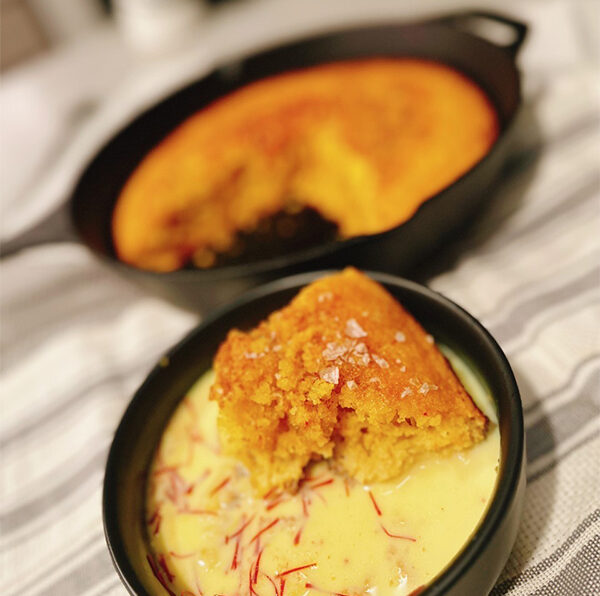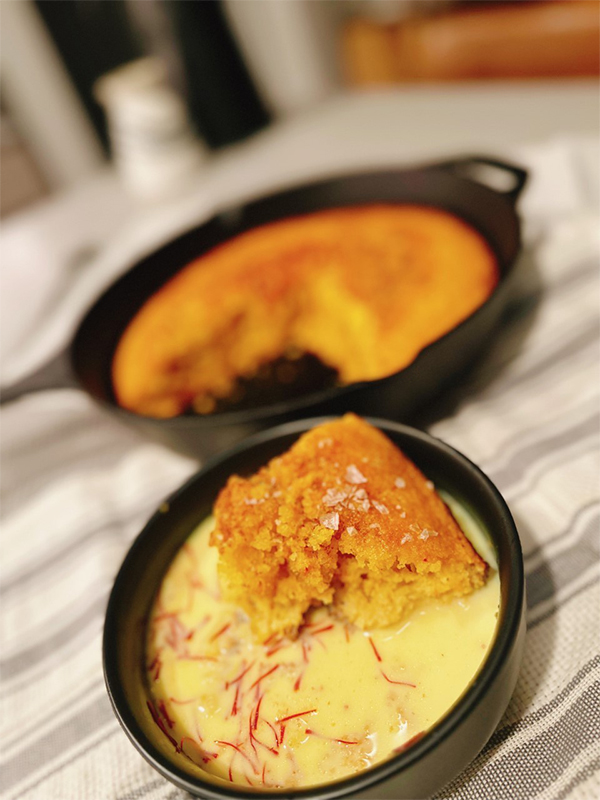Black Muslims have a long history in the Americas, but that history is barely represented. When it is, it is often misunderstood.
Enslaved by Europeans and later transported to North, South and Central America, as well as the Caribbean, these marginalized communities had to fight to preserve their faith amidst enforced Christianity. This often meant observing rituals in secret, including fasting and breaking their fasts during suhoor (morning break fast) and iftar (evening break fast) meals.
It’s a complicated yet rich history that should be acknowledged throughout the entire year, but the Islamic holy month of Ramadan—when Muslims all over the world will fast, pray, study the Qur’an, and reflect on their faith and communities—is the perfect time to honor how Black Muslims have helped shape this tradition. After all, “When we’re thinking about Islam in the United States, we have to understand that Islam here is really rooted in Blackness, in the Black experience,” says Kayla Renée Wheeler, assistant professor of Critical Ethnic Studies and Theology at Xavier University.
In her book Servants of Allah: African Muslims Enslaved in the Americas, award-winning historian and author Sylviane A. Diouf writes that enslaved Muslims in the Brazilian state of Bahia often broke their fast with a dish of cornmeal, milk and honey. Milk and honey are especially significant because they are prophetic foods, and, during Ramadan, Muslims are encouraged to eat prophetic foods. The mortality rate amongst enslaved people in South America and the Caribbean was incredibly high due to work and malnourishment, so fasting was a supreme act of faith for them, in conditions where they were already underfed.
“They were faithful to their religion,” Diouf tells Sweet July. “Not just in terms of dietary laws and Ramadan, but many different aspects of their life. When you find yourself in a situation that is horrible, faith becomes even more important.”
And it was their faith that led enslaved Afro-Brazilians to mount one of the most historically significant slave revolts: the 1835 Malê revolt, which was planned and executed during the month of Ramadan. The Muslims there were known as imalê, deriving from a Yoruba word, which became shortened to Malê. After the revolt, the Bahian officials ordered harsh punishment and the destruction of items related to Islam, including Islamic texts the Malê had written in Arabic.
But the Malê revolt is far from the only example of Black Muslim resistance on this side of the Atlantic Ocean.
The perception of Black Muslims in the Americas is often limited by stereotypes largely because this history isn’t well-known, says Wheeler. Amongst the broader Muslim community, Black Muslims who are in the Nation of Islam or have roots in the Nation are often told they are “fake Muslims.”
Wheeler encourages people to take the month of Ramadan to learn about the diversity of the ummah, the global community of Muslims, and especially Black Muslims in the Americas. She mentions Malcolm X’s sister, Ella Little-Collins, who was a powerful activist in the Black Muslim community in her own right but is rarely recognized.
“She left her masjid because a woman was being abused by one of the male members and no one did anything to stop it,” says Wheeler. “I think she set the example for Malcolm X and how he would act later on when he decided to break away from the Nation of Islam, partly because of the allegations made against [former leader] Elijah Muhammad.”
After leaving her leadership position in the Nation, Little-Collins supported Black and ethnic studies programs in universities across the United States and founded the Sarah A. Little School of Preparatory Arts in Boston. After Malcolm X (he changed his name to El-Hajj Malik el-Shabazz later in life) was assassinated, she went on to become president of his Organization of Afro-American Unity, continuing his work of distributing scholarships for Black students in America to study at Al-Azhar University in Cairo, Egypt and the University of Ghana.
“To be Black Muslim doesn’t mean just being Sunni, or just being in The Nation,” says Wheeler. “There are many other religious minority groups that have played a major role. And Muslims of all races and ethnicities are truly indebted to African American and African Caribbeans who rebuilt Islam in the Americas and in the United States.”
As I pondered what dish to create for Ramadan, I tried to piece together the different parts of this history. I recalled the Ramadan dish Diouf referenced, what enslaved African Muslims in Brazil used to eat to break their fast—cornmeal, milk and honey—and saw a direct diasporic connection to Black Southerners, many of whom grew up eating crumbled cornbread in milk. This was one of my favorite childhood meals. My mother, who was from Alabama, would reheat stale cornbread and crumble it up into a bowl of ice cold milk, adding sugar and a little extra salt for taste.
In the South, cornbread in milk is a popular dish because it represents resiliency and beautiful simplicity. It’s hydrating, which is incredibly important during Ramadan, where those who fast don’t drink water from sunrise to sunset. It’s also an affordable, filling food with centuries of history. For me, it’s a perfect dish for suhoor.
When I spoke to Black Muslim women about my plans for this recipe, some instantly saw themselves in the concept. Karla Kovacik, a biracial Black Muslim woman, told Sweet July that her Grandma Ruth used to make cornbread and milk with pinto beans—a dish she learned from Black farmers in Columbus, Georgia. Kovacik plans to serve this meal to her family and friends this Ramadan.
“[Grandma Ruth] taught me to always have beans and cornmeal on hand for hard times, but also, she said, because it’s just plain good anytime,” says Kovacik. “I taught this to my children, who now request pinto beans and cornbread for supper.”
While Kovacik remembers the dish as savory, Donna Neil-Demir, a Black Muslim woman with roots in the South, ate it a bit sweeter, as I did. “Whenever I think of my childhood, cornbread always comes to mind, the warmth and the smell of it,” Demir tells Sweet July. “It was my beloved father who’d sit at the head of our table with a bowl placed just so, the perfect spot to crumble his cornbread and drench it in either milk with sugar or buttermilk.”
With crumbled cornbread in milk as my vessel, I choose to honor and observe Ramadan in a way that’s firmly rooted in my own Black culture, is intentional about Muslim traditions, and embraces my ever-evolving sense of creativity. So, at the risk of my great-grandmother perhaps looking down on me in shock, I added saffron to this Southern classic. I love to play with aromatics in my cooking; their transformational capabilities are impressive. The earthy grassy flavor of the saffron, with its floral notes, compliments the dish—a perfect marriage of sweet and savory combined with the milk, honey and cornmeal. It adds a complexity to a simple meal that doesn’t feel overwrought or contrived but quite natural. Saffron’s own history is complicated and long, and its presence in South Asian dishes is a subtle nod to both my own Caribbean heritage and the South Asian heritage of many of my loved ones, whom I host for wonderful iftar dinners during Ramadan.
Regardless of whether you’re observing Ramadan or whether you’re Muslim, belong to another religion, or practice no religion at all, this month is a perfect time to intentionally learn about the history of Black Muslims in the Americas—a group of incredibly diverse people who changed the landscape of their surroundings, who practiced resiliency, accountability and community in ways that can inspire us today. Black Muslims in the Americas held onto their religion through impossible circumstances. That deserves recognition.

RECIPE:
Saffron Cornbread with Milk and Honey
INGREDIENTS
- 1 cup flour
- 1 cup fine yellow cornmeal
- 3 tsp baking powder
- 1/4 tsp baking soda
- 1 tsp kosher salt
- 1/2 cup honey
- 2 cups milk
- 1 tbsp Persian saffron (remove if you’d prefer a traditional cornbread)
- 2 eggs
- 12 tbsp unsalted butter
- FOR SERVING
- Pinch of flaky salt such as Maldon
- Honey
- Milk
- Saffron
INSTRUCTIONS
- Place a 10-inch cast iron pan into your oven and preheat the oven to 400 degrees Fahrenheit.
- In a small microwave-safe bowl, heat ¼ cup of the milk in the microwave for about a minute. Gently mix the saffron into the warm milk and set aside until the milk turns a golden color. Skip this step if you’d prefer a traditional cornbread.
- In a large bowl, combine the dry ingredients—the flour, cornmeal, baking powder, baking soda, salt—and whisk.
- In another bowl, whisk together the remaining milk and eggs.
- Using a flat spatula, fold the milk and egg mixture into the dry ingredients, then add your saffron milk and 8 tablespoons of melted butter until your mixture is smooth with no lumps.
- Remove your hot pan from the oven and place on the stovetop on low heat. Take 4 tablespoons butter (½ stick) and rub the stick against the sides of the pan, allowing the rest to melt into the cast iron until it smells toasty and nutty, and becomes brown.
- Pour your cornbread mixture into the cast iron pan and let the sides and bottom sizzle for about 30 seconds to one minute. Be careful not to let the butter turn a dark brown or black color.
- Place the pan into the oven and bake at 400 degrees for 20 minutes.
You can eat this cornbread for an iftar dinner, and if you want to make cornbread and milk for suhoor the next morning, follow the below instructions.
-
In a small microwave-safe bowl, heat ¼ cup of your milk of choice in the microwave for about a minute. Gently mix the saffron into the warm milk, leave it in the fridge or freezer to chill for serving. Skip this step if you’d prefer a traditional cornbread.
-
Reheat your cornbread in the oven at 350 degrees Fahrenheit for 10 minutes or in the microwave or air fryer if pressed for time.
-
In a bowl or glass, crumble or place a slice of cornbread, and pour your saffron milk over it or around it, adding as much cold milk as you’d like. Or if you’re opting for traditional bread, just pour cold milk. Drizzle the mixture with honey and top with flaky salt. Mix and crumble up the cornbread with a spoon and enjoy.







